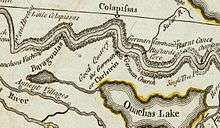German Coast

The German Coast (French: Côte des Allemands) was a region of early Louisiana settlement located above New Orleans on the east side of the Mississippi River – specifically, from east (or south) to west (or north), in St. Charles, St. John the Baptist, and St. James parishes of present-day Acadiana.[2] The four settlements along the coast were Karlstein, Hoffen, Mariental, and Augsburg.[3]
Settlements
Originally, the Germans settled at the Arkansas Post. However, the conditions were intolerable.[4]
The area's name was derived from the large population of German pioneers who were settled along the Mississippi River in 1721 by John Law and the Company of the Indies. When the company folded in 1731, the Germans became independent land owners.[5]
Despite periodic flooding, hurricanes, and the rigors of frontier life, the German pioneers made a success of their settlements. Their farming endeavors provided food not only for themselves but also for New Orleans' residents. Some historians credit these German farmers with the survival of early New Orleans.[6]
Culture
Most of the German Coast settlers hailed from the Rhineland region of Germany, the German-speaking cantons of Switzerland, and other areas. Many came from the German-speaking region of Alsace-Lorraine in France, and some from Belgium.[7]
...today are called Bayou des Allemands and Lac des Allemands (meaning Germans' Bayou and Germans' Lake, in French).
From the time of their arrival, the German immigrants began speaking French and intermarried with the early French settlers. Over the subsequent decades they intermarried with the descendants of the latter as well as the Acadians. Together with other settlers, they helped create Cajun culture.
A number of common Cajun surnames have German origins: for example, Schexnayder (various spellings), LaBranche (a calque of Zweig), and Trosclair (a phonetic macaronic of Troxler).
Military participation

In the Louisiana Rebellion of 1768, German colonists joined with Acadians from the Cabannocé Post area to march on New Orleans and overthrow the new Spanish colonial governor Antonio de Ulloa.
A few years later, the German and Acadian settlers united again, under Spanish colonial governor Bernardo de Gálvez, to fight the British during the American Revolutionary War.[8]
1811 slave uprising
The German Coast was the site of the largest slave revolt in US history, the 1811 German Coast Uprising. This was during the Territory of Orleans period, more than a year before Louisiana became a state.
The rebellion's leaders were Quamana and Harry, slaves, and Charles Deslondes, who gathered an estimated 200 slaves from plantations along the River Road and marched toward New Orleans. The insurgents killed two white men without meeting much resistance, but they were not well armed.
Nearly half of the total ninety-five slaves who died were killed by the local militia. The others received summary executions after tribunals were held in the parishes, including Orleans Parish.[9][10]
World War I
During World War I, in a reaction against Germany as the enemy, the Louisiana state legislature passed Act 114: it prohibited all expressions of German culture and heritage, especially the printed or spoken use of the German language, in the state.[11][12][13]
See also
References
- ↑ "Course Of The River Mississippi, from the Balise to Fort Chartres. Ross, Lieut. 1775" rumsey.geogarage.com
- ↑ Wall et al., Louisiana: A History (Fourth Edition)
- ↑ Merrill, Ellen C. Germans of Louisiana
- ↑ Sternberg, Mary Ann. Along the River Road: Past and Present on Louisiana's Historic Byway
- ↑ Acadian-Cajun Genealogy and history www.acadian-cajun.com
- ↑ "German Americans", University of Louisiana – Lafayette Center for Cultural and Eco-Tourism, accessed 8 Dec 2008
- ↑ The German-Acadian Coast Historical and Genealogical Society
- ↑ CajunCulture.com, original source: Brasseaux, Founding of New Acadia; Taylor, Louisiana; Wall et al., Louisiana
- ↑ Eaton, Fernin (7 November 2011). "1811 Slave Uprising; Governor on Trial: Claiborne in His Own Words". Salon publique, Pitot House, New Orleans. Academia.edu. Retrieved 09/07/2012. Check date values in:
|access-date=(help) - ↑ , African American Registry, 2005, accessed 18 Jan 2011
- ↑ www.louisianafolklife.org "Getting to Gemütlichkeit: German History and Culture in Southeast Louisiana"
- ↑ Louisiana (1918). Acts Passed at the ... Session of the ... General Assembly of the State of Louisiana. James M. Bradford, Printer to the Territory. pp. 188–. Retrieved 2 September 2013.
- ↑ "Acts Passed By The General Assembly of the State Of Louisiana At The Regular Session Begun And Held In The City Of Baton Rouge On The Thirteenth Day Of May 1918", Baton Rouge, Ramires-Jones Printing Co., 1918, p188
External links
- The German-Acadian Coast Historical and Genealogical Society
- History of the Cajuns – The German Coast of Louisiana
Coordinates: 29°55′44″N 90°20′22″W / 29.92889°N 90.33944°W